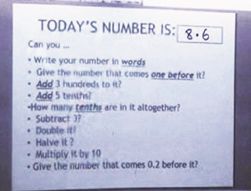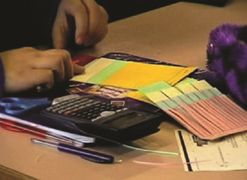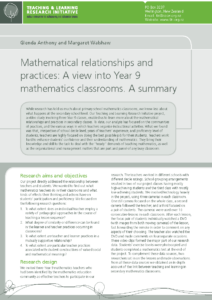While research has told us much about primary school mathematics classrooms, we know less about what happens at the secondary school level. Our Teaching and Learning Research Initiative project, a video study involving three Year 9 classes, enabled us to learn more about the mathematical relationships and practices in secondary classes. To date, our analysis has focused on the communities of practices, and the various ways in which teachers organise instructional activities. What we found was that, irrespective of school decile level, years of teachers’ experience, and proficiency level of students, teachers are highly focused on doing the best possible job for their students. Teachers work hard to enhance students’ confidence and their understanding of mathematics. They bring their knowledge and skill to the task to deal with the “heady” demands of teaching mathematics, as well as the organisational and management matters that are part and parcel of any busy classroom.
Research aims and objectives
Our project directly addressed the relationship between teachers and students. We wanted to find out what mathematics teachers do in their classrooms and what kinds of effects their thinking and actions have on students’ participation and proficiency. We focused on the following research questions:
- To what extent does an individual teacher employ a variety of pedagogical approaches in the course of teaching a lesson sequence?
- What degree of similarity or difference can be found in the learner and teacher practices occurring in classrooms?
- To what extent are teacher and learner practices in a mutually supportive relationship?
- To what extent are particular teacher practices associated with student constructions of valued social and mathematical meanings?
Research design
We invited three Year 9 mathematics teachers who had been identified by the mathematics education community as effective teachers to participate in our research. The teachers worked in different schools with different decile ratings. School grouping arrangements resulted in two of our project classes having mostly high-achieving students and the third class with mostly low-achieving students. We involved technology heavily in the project, using three cameras in each classroom. One still camera focused on the whole class, a second camera followed the teacher, and a third focused on a pair of students. The cameras were used over 10 consecutive lessons in each classroom. After each lesson, the focus pair of students individually watched a DVD (with images from both moving cameras) of the lesson, fast forwarding the remote in order to comment on any aspects of their choosing. The teacher also watched the DVD and made comments on four separate occasions. These video clips formed the major part of our research data. Students’ exercise books were photocopied and students completed a mathematics test at the end of the project. To complement these data sources, two researchers sat in on the lessons and made observations. From all these data sources we obtained an in-depth account of the link between teaching and learning in secondary mathematics classrooms.
What we found
We have placed our findings into five main groups: how teachers dealt with student diversity; the effect of professional development on teaching practices; the use of starter activities for lessons; the use of worked examples in lessons; and students’ perceptions of a good teacher and good teaching.
Dealing with student diversity
One of our main interests was how teachers work at developing positive outcomes for the diverse students in their the classrooms. We were particularly interested in this because it has been well documented that issues relating to student diversity are among the most complex and challenging issues facing education today.
We found that all three teachers grounded their practice in an ethic of care. As one of the teacher said in interview: “You kind of take care of the kids in your class.” He wanted his students to develop a sense of belonging and wellbeing in the class and he was able to establish a very hospitable classroom. He was particularly attentive to cultural customs and pointed out: “I don’t give praise individually because Ma¯ ori kids don’t like it.” He worked hard at building inclusive relationships that allowed every student to develop a sense that they could achieve in mathematics.
The teacher had developed a “togetherness” environment. He ensured that he nurtured every student, irrespective of level of mathematical proficiency. Along with the caring and social nurturing that took place in this classroom, there was a sense of respect. As one student explained: “[It’s] a two-way thing because to get respect you have to respect back, like you have to give them respect before you get respect back.” The student went on to say: “He actually listens to what we are saying because most teachers don’t. They don’t really care what we are saying and they think they are always right all of the time and they won’t listen to our side of it.”
The teacher was confident in the reasoning powers of his students. Within the supportive community he had established, students were also confident in the soundness of their mathematical identities. The value he placed on students’ thinking and reasoning influenced the way in which the students viewed themselves and their relationship with mathematics.
Teaching as learning: Pedagogical shifts
Two of the teachers had recently participated in Senior Numeracy Project (SNP) and this provided the research team with an opportunity to explore how the professional development had influenced and changed their teaching practices.
We focused on one of the teachers. She told us that after being involved in the SNP she taught fractions differently: “I mean I totally changed what I would have normally have done for Year 9.” She went on to say that her classroom practice “used to focus on what to do rather than the understanding … ordering, equivalent fractions, different representation plus the algorithm … but [I now realise that] understanding of concepts are important.” Armed with evidence provided by the project’s diagnostic interview, the teacher pointed out: “I knew fractions were difficult for students but I hadn’t realised quite what was so difficult … when you look at it more, you realise just how complex fractions are.”
The teacher was very keen to encourage her students to share their solution strategies. However, she came to appreciate how change does not happen instantaneously and that teacher learning continues in the classroom. Reflecting on the lessons, she drew attention to the difficulties in anticipating and or understanding the varied ways students reasoned about fractions. Encouraging students to talk about their mathematical thinking created opportunities for further teacher learning.
Lesson starter activities
The research team looked in detail at the activities that teachers used at the beginning of their lessons. We wanted to find out whether or not starter activities across the three classrooms followed the same pattern and whether or not they served the same purpose. Our analysis focused on the first set of instructional activities in the lessons. That meant we did not analyse the administrative, organisational and pastoral care activities that the teacher undertakes at the beginning of lessons.
When we analysed the first teacher’s starter activities we found that the teacher typically used springboard tasks. By springboard tasks we mean activities that lead students into developing new knowledge (see Figure 1). These tasks represented around 25 percent of the whole lesson for the first teacher.
Figure 1: A typical springboard task
 |
A group of students were decorating packaging for delivery to elderly patients at a convalescent home. They needed 1/4 yard of ribbon for each package. They had only 4 1/2 yards of ribbon left. How many packages could they decorate? |
Most of the second teacher’s starter activities were consolidation tasks—typically a “quick-ten” set of revision questions (see Figure 2).
Figure 2: A typical consolidation task

These took about 20 percent of the overall lesson time. In using consolidation tasks, the teacher was providing opportunities for students to firm up skills and strengthen understanding of work that had already been introduced.
The third teacher’s starter activities consisted of some consolidation tasks and some springboard tasks, as well as a combination of both. In 5 of the 10 lessons of the third teacher, students worked on these beginning lesson activities individually for more than 40 percent of class time. The springboard tasks presented elements of challenge. They tended to arouse the curiosity of the teacher’s high achieving class, and provided a context for knowledge about to be introduced.
In all three classrooms, starter activities were a regular routine. There were a number of elements of practice that remained consistent from one teacher to another. For example, the starters in each classroom provided students with space and time to work on their own and/or with peers without whole-class teacher guidance. While the students were engaged in the starter activities the teachers roved around the classroom, continually monitoring understanding and scaffolding individual learning.
Instructional worked examples
Providing examples is part of daily classroom routine of all mathematics teachers. Research has shown that when the teacher provides examples that students can make sense of, and when the teacher makes connections between the examples used, students become engaged in the tasks set and their understandings are enhanced. Our investigations to date have looked in depth at two examples used by two of the teachers.
The fraction fringe (see Figure 3) used in one classroom involved dividing a unit strip into halves, quarters, eighths, and so on, and dividing a unit strip into thirds, sixths, twelfths, and so on. In constructing their own fraction fringes, students focused on identifying the doubling relationship in the denominator of the fractions. Followup activities allowed the students to use the fraction fringes to find equivalent fractions. While the exploration was enjoyed by the students, our analysis revealed that its potential in enhancing students’ understanding was not captured fully for students at this level.
Figure 3: Student’s fraction fringe

In another unit of work on linear equations, our initial analysis of the examples the teacher used has focused on the way the teacher varied the kinds and level of difficulty of the problems given to students at the start of lessons. Our analysis showed how the carefully considered progression of learning through these chosen examples attracted the learner’s attention and served to enhance student learning.
Student perceptions of good teachers and teaching
Teachers in the project were all experienced and highly regarded by their professional peers. All students interviewed considered their teacher a “good teacher”. Despite the fact that the three teachers in the study had different teaching approaches, there were attributes in common that the students identified as “good” teaching. In a broad sense, the attributes that students valued were classified as “being a caring teacher” and “being able to explain mathematics well”.
When students talked of their caring teacher, they spoke of how their teacher knew the students well, and how the teacher included everyone in a togetherness environment. The high-achieving students in our first project classroom considered their teacher as a “good teacher” because she understood where they “were” mathematically; created opportunities for all to contribute; and because she wanted them to be confident mathematically. Caring involved the teacher making sure that the students were provided with the mathematics tasks and practice opportunities and environment needed to progress and do well in tests.
The group of low-achieving students in our second project classroom valued their teacher because he “understood” them as individuals; he tolerated their need to express themselves in sometimes less than conventional ways; he encouraged them to participate; and that he boosted their confidence as mathematics learners. For these students, care included respect for the individual as a social person as well as a mathematical learner.
In the third classroom, the high-achieving students interpreted their teacher’s practice as wanting them to learn and understand mathematics and providing an environment where they could take risks and respond to challenges individually, and in groups, and within the whole class. They saw their responsibility as students to communicate effectively in the classroom, not just about what they knew, but also about what they did not yet understand.
Conclusions and implications
Our research has shown that teachers’ work is multifaceted and complex, and hence is constantly changing. Pedagogical practices change not only in response to competing demands within the classroom but also in response to teachers’ continual search for new ways to enhance outcomes, in their many forms, for their students. What we observed was that mathematics teaching that contributes to positive student outcomes involves allowing students to take risks and respond to challenge, and has an expectation that students will communicate effectively, and will become confident learners. Our findings and their implications are summarised in Table 1.
| Findings | Implications |
|---|---|
| Students greatly value a classroom that has a “togetherness” environment. They believe that respect in the classroom is important and involves a two-way process. | Teachers’ work should be based on an ethic of care. Teachers spend time building productive relationships and nurturing confidence. They value students’ diverse contributions |
| The classroom provides a context for applying a teacher’s professional learning. | Unpacking students’ solution strategies provides teachers with opportunities to deepen their understanding about students’ mathematical thinking |
| Mathematics classes begin in different ways, with different purposes and with different effects but all provide students with space and time to work on their own. | Coherence between lessons is important. Starter tasks can provide opportunities to consolidate learning or link prior learning to new learning |
| These teachers were highly aware of the importance of keeping an “eye on the mathematical horizon” (Ball, 1993). The tasks that teachers choose significantly influence students’ level of engagement, their opportunity to learn and their proficiency development. | Tasks need to have a mathematical focus, have an element of challenge, and be linked to students’ prior knowledge and experience |
| Students define “good” mathematics teaching in different ways. Their definitions tend to match the social and mathematics obligations within their respective classrooms. Students’ understandings and valuations of the obligations that they need to fulfill to be effective mathematical students impact significantly on their participatory identities as mathematical learners | For all students learning opportunities should focus not just on enhancing mathematical knowledge but also on the development of ways to participate more proficiently in mathematical practices—the ways of doing and learning about mathematics. |
Project presentations and publications
Anthony, G. (2009). The learners’ perspective: New Zealand Year 9 students’ views on ‘good’ mathematics teachers and learners. Paper presented at the Redesigning Pedagogy International Conference Singapore.
Ding, L., Anthony, G., & Walshaw, M. (May, 2009). The structure of mathematics lessons in New Zealand. Paper presented at the 3rd International Symposium on the History and Pedagogy of Mathematics, Beijing, China.
Ding, L., Anthony, G., & Walshaw, M. (2009). Implementation of examples in solving number problems. In M. Tzaekaki, M. Kaldrimidou, & H. Sakonidis (Eds.), Proceedings of the 33nd conference of the International Group for the Psychology of Mathematics Education(Vol. 2, pp. 425-432). Thessaloniki: PME.
Lawrence, A. Anthony, G., & Ding, L. (2009) Teacher learning and pedagogical shifts subsequent to professional development experiences. New Zealand Journal of Teachers’ Work, 6(2), 138- 147.
Walshaw, M., Ding, L., & Anthony, G. (2009). Enhancing mathematical identities at the expense of mathematical proficiency? Lessons from a New Zealand classroom. In M. Tzekaki, M. Kaldrimidou, & H. Sakonidis (Eds.), Proceedings of the 33rd conference of the International Group for the Psychology of Mathematics Education (Vol. 5, pp. 313-320). Thessaloniki: PME.
Lead researchers and authors
Glenda Anthony and Margaret Walshaw are codirectors of the Centre of Excellence for Research in Mathematics Education at Massey University. Their research interests focus on understanding how classrooms can be places here all learners, irrespective of age, can develop positive mathematical identities and become powerful mathematics learners.
Associate Researchers: Tim Burgess, Liping Ding, Anne Lawrence, and Peter Rawlins



